BPSC (Bihar) Exam > BPSC (Bihar) Notes > Foreign Invasions on India and their Impact
Foreign Invasions on India and their Impact - BPSC (Bihar) PDF Download
Foreign Invasions on India and their Impact
Arab and Turkish Invasions of India
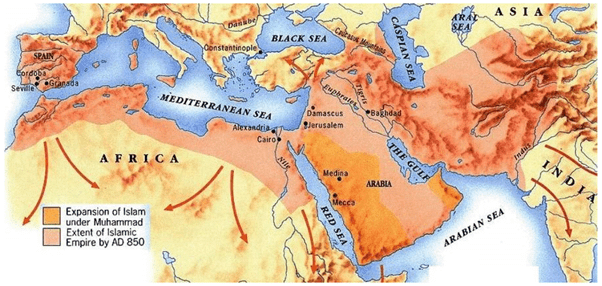
- The first incursion by the new Muslim successor states of the Persian Empire occurred around 664 CE during the Umayyad Caliphate, led by Mohalib towards Multan in Southern Punjab, in modern-day Pakistan.
- Mohalib’s expeditions were not aimed at conquest, though they penetrated only as far as the capital of the Maili, he returned with wealth and prisoners of war.
- This was an Arab incursion and part of the early Umayyad push onwards from the Islamic conquest of Persia into Central Asia, and within the limits of the eastern borders of previous Persian Empires.
Arabs Invasions
- During the Khaliphate of Omar, Arab forces made fertile attempts to get Bombay.
- Arabs captured Sindh in 712 AD.
- The Arab conquest of Sindh was led by Muhammed Bin Kassim.
- Muhammed Bin Khasim was the nephew of Al- Hajaj, the governor of the Arab province of Basra.
- Dahir, a Brahmin was the ruler of Punjab at that time. He was killed by Kassim.
- The Arabs lost control over Sindh in 779 AD.
- Arab conquest of Sindh resulted in the spread of Islam to North India.
- But Islam was first introduced in India by Malik Ibn Dinar in Kerala in 644 AD.
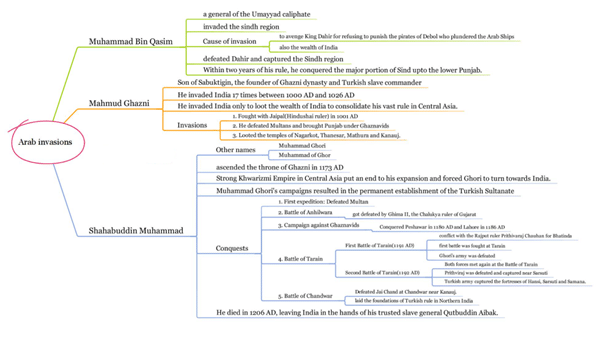
Turkish Invasions
- Ghazni in Afghanistan was ruled by a Turkish family called Gamini of the Ghaznavid dynasty.
- Muhammed Ghazni was the first Turkish conqueror of North India.
- Muhammad Ghazni’s father was Subu ktigin.
- He attacked India only for want of wealth.
- He attacked India seventeen times between 1000 and 1027 AD. He made all the raids in the guise of Jihad.
- First Invasion was in 1001 AD.
- He defeated Jaipal and Anandpal of the Shahi dynasty in 1001 and 1009 respectively.
- The most important raid of Muhammed was the Somanath expedition. It was in 1025. He completely destroyed the temple. Somanath Temple was on the sea coast of Gujarat.
- Muhammed Ghazni died on 30th April 1030.
- Later his son Masud attacked India and captured Kashmir.
- The famous Persian poet Firdausi who wrote ‘Shahnama’ (The Book of Kings) lived in his court.
- Alberuni, an Arab Historian, who wrote Tarikhul- Hind (Reality of Hindustan), accompanied Muhammed Ghazni to India.
- Al-Firdausi is known as ‘Indian Homer’, ‘Persian Homer’, or ‘The Immortal Homer of the East’.
- Muhammed of Ghore attacked India between 1175 and 1206 AD.
- Muhammed Ghori made his first expedition to India and captured Multan in 1175 AD.
- In the First Battle Tarain in 1191 (near Taneswar) Muhammed Ghori was defeated by the Rajput forces under Prithviraj Chauhan III.
- In the Second Battle of Tarain (1192 AD) Muhammed Ghori assisted by Qutub-ud-din Aibek a slave, defeated Prithviraj Chauhan III and killed him.
- In 1193 Muhamed Ghori attacked Jaichand, father in law of Prithviraj. III at Kanauj, Jaichand was defeated.
- Muhammed Ghori returned from India by intrusting his territories in India in the hands of Qutub- Uddin Aibak.
- After the death of Ghori in 1206 Aibek founded the Slave Dynasty.
- Muhammed Ghori's Indian invasion resulted in the foundation of Islamic rule in India.
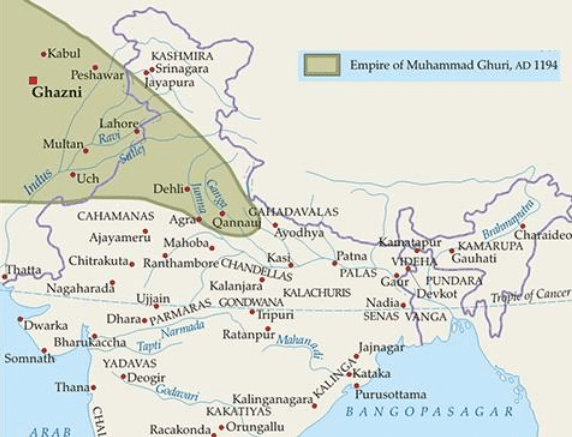
Persian empires
- The first attack of Arabs under Ubaidullah failed. He was defeated and killed, After this, a series of expeditions were sent to conquer an outpost of Sindh, which all ended in failure.
- Then Hajjaj made elaborate preparation for the attack on Sindh and sent a powerful army under the command of his nephew and son-in-law Muhammad bin Qasim in 711 AD with 6000 horses, 6000 camels, 3000 animals loaded with equipment and a large infantry.
- Muhammad bin Qasim proceeded towards Sindh through Makarana and first conquered Debel where he received fresh reinforcement sent by Hjjaj through the sea.
- Sind, a principality on the shores of the Arabian Sea and the lower reaches of the Indus, was invaded from the sea by the Muslims in 711.
- The seaport of Daibul fell first, then several towns on the banks of the Indus, including Arur, the capital. Finally, in 713, the Arabs took Multan and the conquest was complete. The fall of Sindh opened the way to the markets of Central Asia.
The Ghaznavid Invasion of India
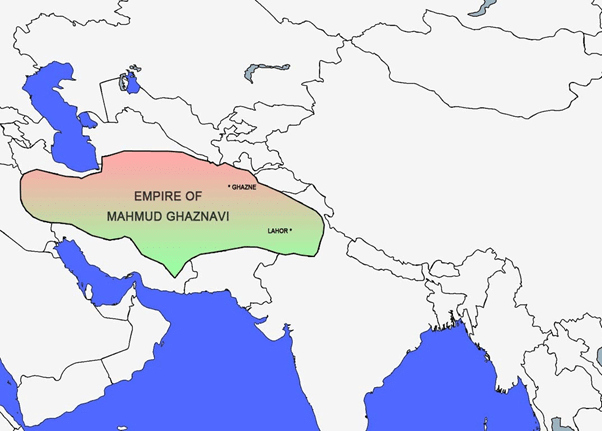
- The Ghaznavid Dynasty was founded after the Turk slaves reached higher posts, such as commanders-in-chief, in the Samanid court; they then took over the state of Khorasan.
- The real founder of the Ghaznavid Dynasty is, in fact, Sabuktigin. It was in his time that the Ghaznavid sovereignty expanded.
- Mahmud Ghazni was Son of Sabuktigin, the founder of Ghazni dynasty & Turkish slave commander.
- In all Mahmud Ghazni invaded India 17 times during AD 1000–1026.
- Mahmud Ghazni first encountered the Hindushai ruler, Jaipal in AD 1001.
- In the years AD 1004–06 Mahmud Ghazni attacked the rulers of Multan.
- Soon Punjab also passed into the hands of the Ghaznavids. Between AD 1014–1019, Mahmud enriched his treasury by looting the temples of Nagarkot, Thanesar, Mathura and Kanauj.
- The attack against Nagarkot in AD 1008 has been described as his first great triumph.
- In AD 1025, Mahmud embarked on the most ambitious Indian campaign, the attack on the Somnath temple in Saurashtra.
- Mahmud captured the city after a grim struggle in which more than 50,000 defenders lost their lives.
- Mahmud left Somnath after a fortnight when he came to know that the Gujarat king Bhima-I had completed preparations to confront him.
- His attacks on India were an attempt to fulfil his ambition to make Ghazni the formidable power in the politics of Central Asia.
- Mahmud’s raids into India were only to acquire the famous wealth of India.
- This wealth would help him to consolidate his vast rule in Central Asia.
- He did not wish to establish an empire in India.
- The Ghaznavids had their control on parts of Punjab and Sind which continued till AD 1135.
- However, his invasions exposed the weak defence of Indian kingdoms. They also opened the possibility of attacks in future by the Turks.
The Mongol Invasion of India
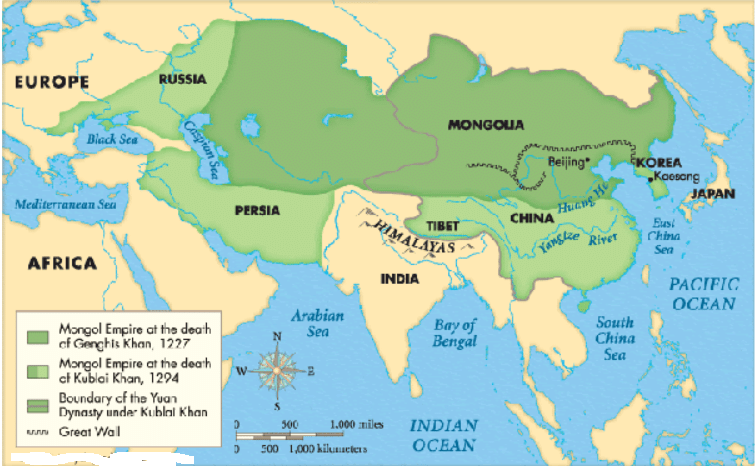
- During Sultan Qutb-ud-din Aibak’s time, the Mongols, appeared in the East of India and emerged as a great power under the leadership of Genghiz Khan (1165-1227).
- He was born in 1165 to Yesugei and Hoelun.
- He was brought up by his ablest mother Hoelun after his father was poisoned to death by Tatars.
- In his incessant wars, he exhibited such remarkable traits of heroism and diplomacy that led him to transform the entire social and military structure of Mongolia.
- The Mongol troops had a strict code of discipline and harsh penalties for infringements of regulations.
- The Mongol hordes were divided in units of 10, 100, 1,000, and 10,000 soldiers (known as an arban, jagun, minghan and tümen respectively; the latter corresponds to a modern regiment).
- Under this system fighters from different tribes were united in unified military formations, whose chief strategy was to “march divided, attack united,” and the strategies used were based on large-scale skirmish manoeuvres that helped the Mongols defeat numerically superior but fragmented forces from the Oxus to the Volga.
- While chasing Jalal-ud-Din Khwarzam Shah (Ruler of Khwarazmian dynasty), Genghiz Khan stormed Afghanistan and the territories nowadays parts of Pakistan.
- Initially, Jalal-ud-Din defeated an advanced Mongol army with the help of the Afghan fighters.
- However, after the coming of Genghiz Khan, Jalal-ud-Din left Ghazni and entered the areas of the Delhi Sultanate and encamped at the west bank of river Indus.
- In December 1221 AD, Genghiz Khan followed him and crushed his army while he fled crossing the Indus waters.
- He was given refuge by the Delhi Sultan. Genghiz Khan marched back due to the hot summer.
- But on his way back he devastated present-day Punjab, Afghan borderland, Ghazni and Herat.
- In 1235 Mongol force invaded Kashmir, stationing a darughachi (administrative governor) there for several years, and Kashmir became a Mongolian dependency.
- In 1285 AD, the Mongols invaded Multan and killed Prince Muhammad Khan.
- During the reign of Ala-ud-din Khilji, Mongols invaded the country several times but were successfully repulsed.
- From these invasion Alla-ud-din Khilji learnt the lessons of keeping himself prepared, by fortifying and organizing his armed forces.
- The invasion of Mongol ruler Timur in 1398 A.D. sealed the fate of the Tughluq dynasty.
- Muhammad fled and Timur captured the city and destroyed many temples in north India.
- Thousands of people were killed and Delhi was plundered for fifteen days, Timur returned to Samarkhand carrying away a large amount of wealth with him.
Persian Invasion of India
A few important points about the Persian Invasion of India:
- Cyrus, the founder of the Achaemenid Empire in ancient Iran invaded the North-Western front of India in 550 BCE.
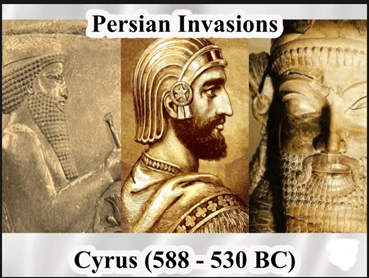
- At that time, there were many small provinces like Gandhara, Kamboja, and Madra who were constantly fighting one another.
- At that time, Bimbisara of the Haryanka dynasty was ruling over Magadha.
- Cyrus succeeded in bringing under Persian control all the Indian tribes west of the Indus like Gandhara.
- Punjab and Sindh were annexed by Darius I, Cyrus’s grandson.
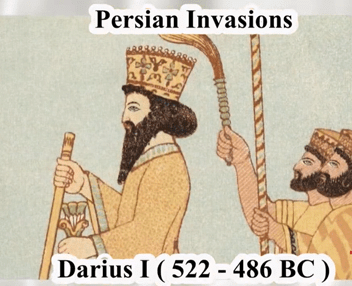
- Son of Darius, Xerxes, could not move ahead with the further conquest of India because of war with the Greeks. He had employed Indian cavalry and infantry.
The effects of the Persian Invasion in India
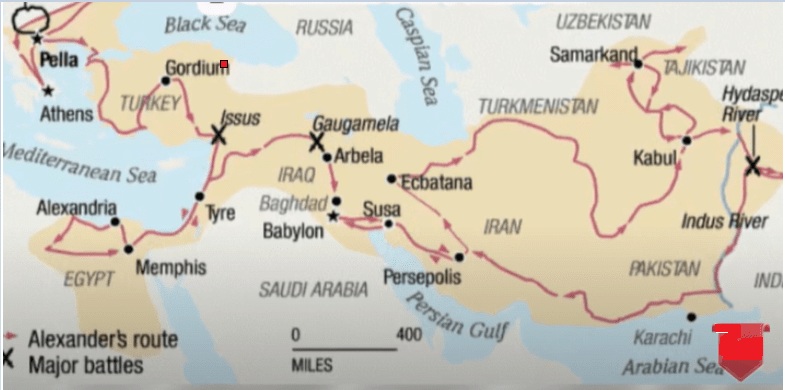
- The Indo-Iranian contact lasted for about 200 years. It gave an impetus to the Indo-Iranian trade and commerce.
- Iranian coins are also found in the northwestern frontier which points to the existence of trade with Iran.
- The Kharoshti script was brought to northwest India by the Persians.
- Some inscriptions of Ashoka were written in the Kharoshti script in these parts.
- Kharoshti script is derived from the Aramaic script and is written from right to left.
- Probably, the rock inscriptions used by Ashoka in the 3rd century BCE were inspired by the Persian king Darius. The monuments of Ashoka’s time, especially the bell-shaped capitals and the preamble of Ashoka’s edicts, have a lot of Iranian influence.
Greek Invasion of India and its Impact
Alexander’s Invasion (327 BCE)
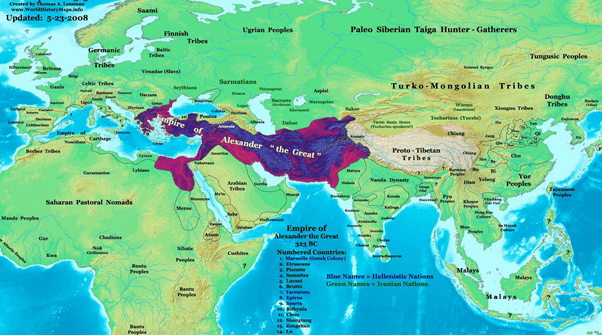
- Alexander (356 BCE – 323 BCE) was the son of Philip of Macedonia.
- He became king in 336 BCE.
- At that time, i.e., in the fourth century BCE, the Greeks and the Iranians were fighting for the supremacy of the world.
- Alexander had conquered Asia Minor along with Iran and Iraq. He then marched into northwest India from Iran.
- He had annexed the whole of Persia (Babylon) by defeating Persian King Darius III in the Battle of Arbela (330 BC).
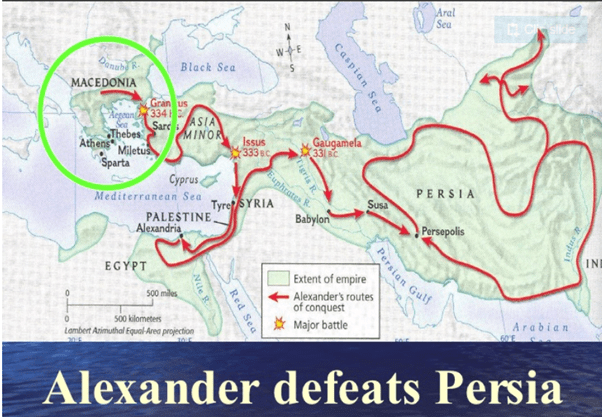
- Alexander was attracted to India’s wealth. Apart from that, he was also believed to have a strong passion for geographical inquiry and natural history.
- In northwest India, just before Alexander’s invasion, there were many small rulers like Ambhi of Taxila and Porus of the region of Jhelum (Hydaspes).
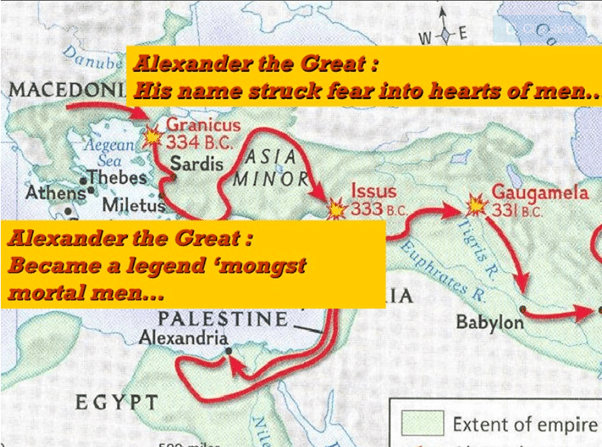
- Ambhi accepted Alexander’s sovereignty but Porus put up a valiant but unsuccessful fight.
- Alexander was so impressed with Porus’s fight that he granted him his territory back. Porus might have accepted lordship. The battle between him and Porus is called the Battle of Hydaspes.
- After that, Alexander’s army crossed the river Chenab and annexed the tribes between Ravi and Chenab.
- But his army refused to cross the river Beas and revolted. They were exhausted after years of battles, were homesick and diseased.
- Alexander was forced to retreat in 326 BCE. On his way back, he died at Babylon in 323 BCE aged 32.
- His dream of an eastern empire remained unfulfilled. To mark the farthest point of his advance, he erected twelve huge stone altars on the northern banks of Beas. He remained in India for 19 months.
- After his death, the Greek Empire split in 321 BCE.
- In northwest India, Alexander left four of his generals in charge of four regions, one of them being Seleucus I Nicator, who would later trade his territories in the Indus Valley with Chandragupta Maurya.
- Eudamas was the last General of Alexander in India.
Effects of Alexander’s Invasion
- Alexander’s invasion augmented political unification in northern India under the Mauryas. The destruction of the small states in north-west India by Alexander aided the Mauryan empire’s easy expansion and also encouraged the Mauryas to capture the northwestern frontier of India.
- The most important result of this invasion was the establishment of direct contact between India and Greece in different fields. Alexander’s invasion opened up four distinct routes – three by land and one by sea and these routes paved the way for Greek merchants and craftsmen to establish trade between India and Greece.
- Alexander’s historians have left clearly dated records of Alexander’s campaign, which have enabled to build of the Indian chronology for subsequent events on a definite basis. They have given important information about the social and economic conditions of that period. There is the mention of the sati system, the sale of girls at marketplaces by poor parents and the fine breed of oxen in northwest India. Alexander sent 200,000 oxen to Macedonia for use in Greece. The historical records tell us about the most flourishing craft of that time – carpentry. Chariots, boats and ships were built by carpenters.
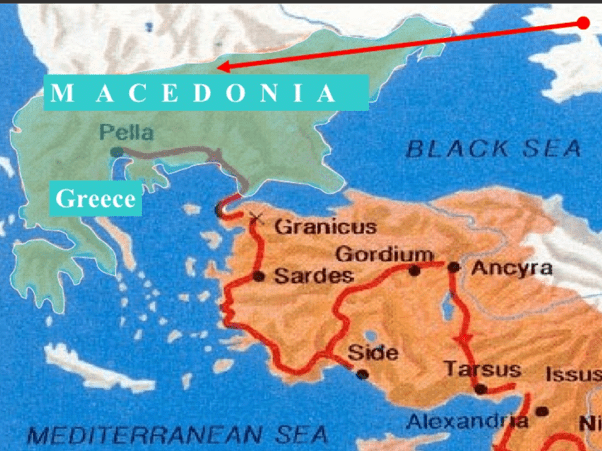
- Post the invasion there were Indo-Greek rulers in the northwest part of India.
- Some of the Greek settlements continued to live in northwest India, under both Chandragupta Maurya and Ashoka. The most important of them was the city of Alexandria in the Kabul region, Bonkephala on the Jhelum and Alexandria in Sindh.
- Grecian impact on Indian art can be seen in the Gandhara school of art.
The document Foreign Invasions on India and their Impact - BPSC (Bihar) is a part of BPSC (Bihar) category.
All you need of BPSC (Bihar) at this link: BPSC (Bihar)
FAQs on Foreign Invasions on India and their Impact - BPSC (Bihar)
| 1. What was the impact of the Greek invasion on India? |  |
Ans. The Greek invasion of India, led by Alexander the Great, had several impacts on the region. It introduced Greek cultural influences to India, leading to the spread of Hellenistic art, architecture, and philosophy. It also facilitated trade between the two regions, resulting in the exchange of goods, ideas, and technologies. Additionally, the invasion marked the beginning of the Indo-Greek kingdoms in the northwest of India, which lasted for several centuries.
| 2. How did the Greek invasion affect Indian society? |  |
Ans. The Greek invasion had a significant impact on Indian society. It influenced the development of Indian art and architecture, particularly in the Gandhara region, where Greco-Buddhist art emerged. The invasion also introduced new military tactics and technologies to India, which were adopted by Indian rulers in subsequent centuries. In terms of religion, it led to the synthesis of Greek and Indian mythologies, resulting in the fusion of Greco-Roman and Hindu deities.
| 3. What were the major trade connections established as a result of the Greek invasion? |  |
Ans. The Greek invasion of India resulted in the establishment of major trade connections between Greece and India. The Greeks brought luxury goods such as silk, spices, and precious stones from India to the Mediterranean region. In return, they exported goods like wine, olive oil, and textiles to India. These trade connections played a crucial role in the economic development of both regions and contributed to the cultural exchange between the Greeks and Indians.
| 4. How did the Greek invasion shape the political landscape of India? |  |
Ans. The Greek invasion had a lasting impact on the political landscape of India. It led to the emergence of Indo-Greek kingdoms in the northwest of the country, with Greek rulers establishing their rule in regions such as Gandhara and Punjab. These kingdoms served as important political entities for several centuries, blending Greek and Indian cultural elements. The invasion also influenced the formation of alliances and rivalries among Indian rulers, as they sought to counter or collaborate with the Greeks.
| 5. Did the Greek invasion have any long-term consequences for India? |  |
Ans. Yes, the Greek invasion had long-term consequences for India. It opened up avenues for cultural exchange, leading to the synthesis of Greek and Indian artistic and religious traditions. The Indo-Greek kingdoms that emerged as a result of the invasion played a significant role in shaping the political landscape of India. Moreover, the trade connections established during this period had a lasting impact on the economy of both Greece and India. Overall, the Greek invasion left a lasting imprint on various aspects of Indian civilization.
Related Searches














